I don’t know about you, but I absolutely adore string of heart plants. The beautiful heart shaped leaves that adorn the hanging vines make for beautiful indoor plants. I wish I could own a million of them; and the good news is- I can!
With simple propagation techniques, you can make one string of hearts plants multiply until you have a whole nursery full of them.
In this article, we’ll be going over four main propagation methods: water, soil, tuber, and butterfly.
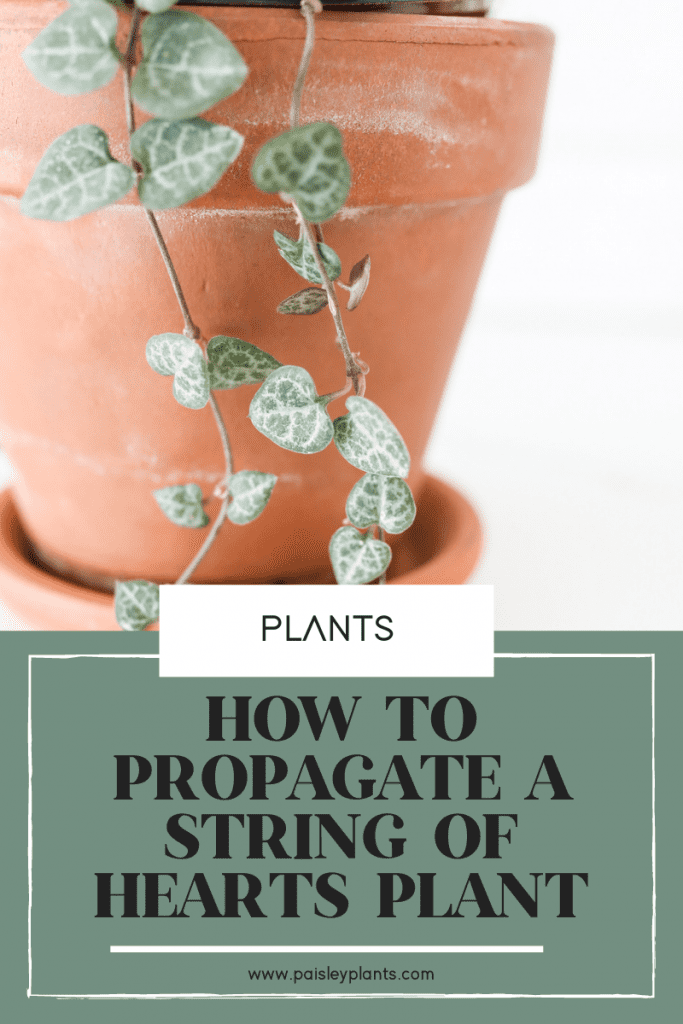
This post includes affiliate links.
Table of Contents
Background Information
The Ceropegia woodii, more commonly known as the string of hearts, rosary vine, or chain of hearts is a perennial variety of hanging succulents. Native to South Africa, this plant lends its name from the little heart-shaped leaves that grow on a thin, stringy vine.
During the summer and fall, you might also notice your string of hearts blooming flowers.These unique flowers are pink or purple and oddly resemble an upside-down mushroom.
In addition, the string of hearts is a safe plant to own if you have small children and pets, as it is nontoxic.
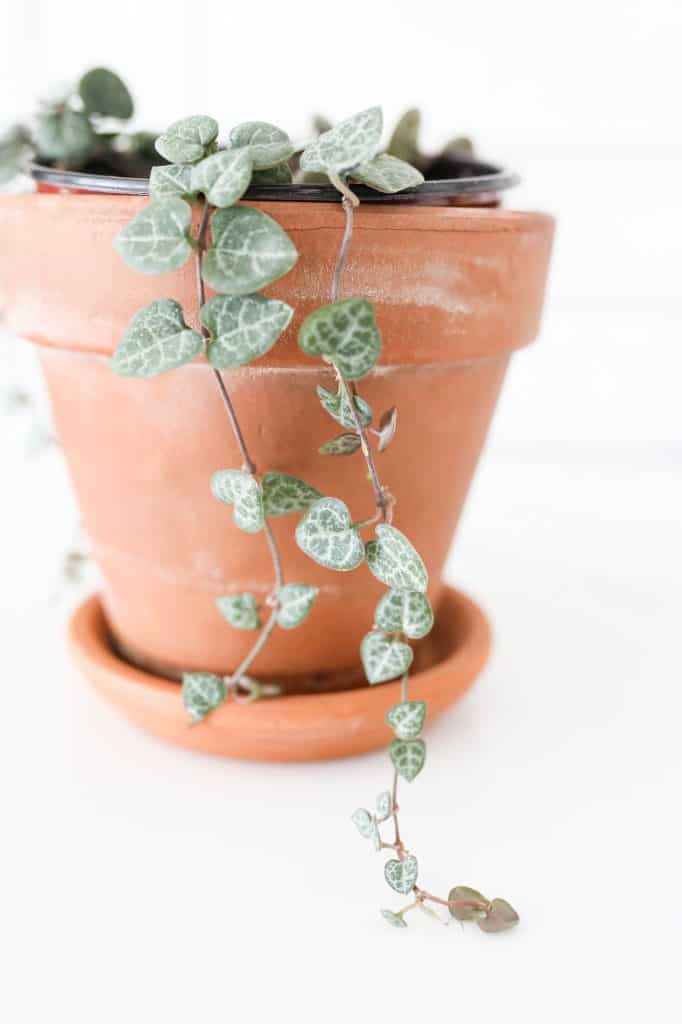
Are String of Hearts Hard to Propagate?
Not at all! In fact, I find the string of hearts to be one of the easiest plants to propagate because there are so many different options you can take when propagating this plant!
Let’s go further into detail on four different methods of propagating string of heart plants.
With all of these methods, the best time to propagate your plant is during the growing season (spring to late summer). This will give you the right conditions for a successful propagation.
That doesn’t mean you can’t try during the winter season though! I’ve propagated many plants in the winter simply out of necessity and many of them have been successful.
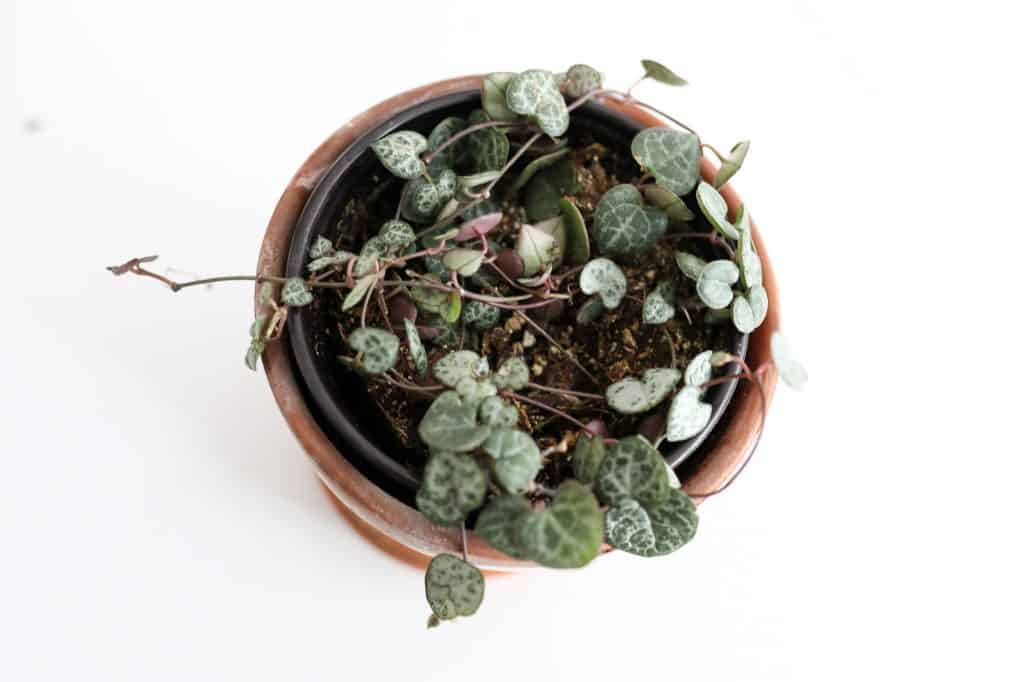
1. Water Propagation
The easiest way (in my opinion) is water propagation. I like to see the new roots forming in the water so I know my new string of hearts plant is healthy and ready to plant into it’s new pot. Here’s how you do it.
1. Remove a pice of vine
Using a pair of sterile, sharp shears or scissors, cut off a piece of the vine from the mother plant. For best results, this vine should be at least 3 to 4 inches in length and contain at least two nodes (the stem of the vine that grows leaves).
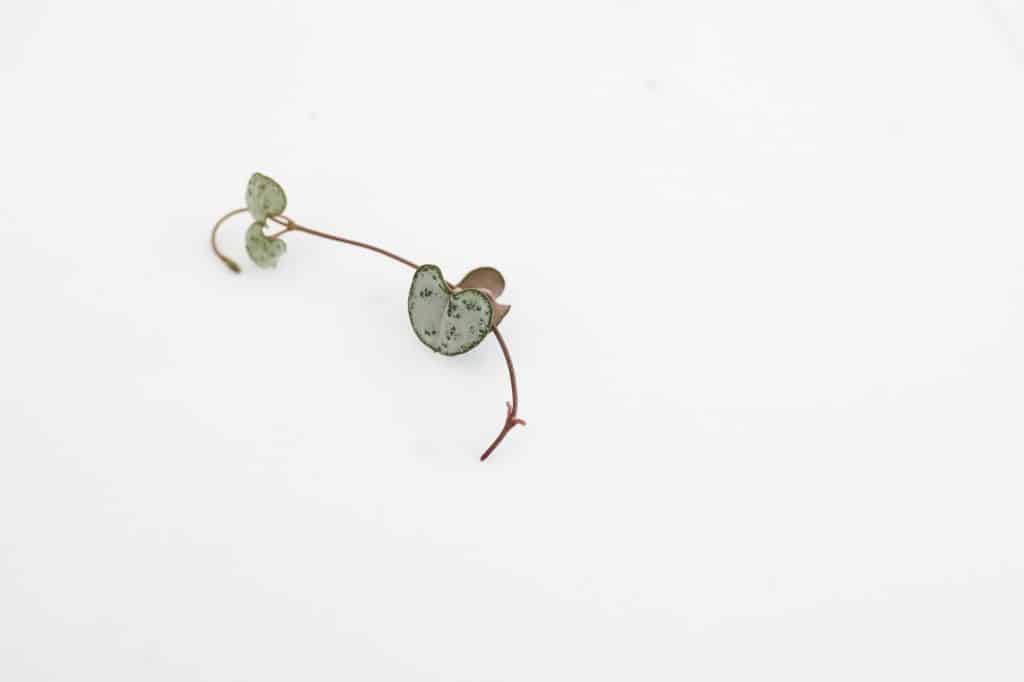
2. Put in water
Place your vine cutting in a glass or propagation station of clean water. Check to make sure no leaves are submerged under the water.
If there are, please trim them off. Wet leaves heighten the chance of bacterial infections.
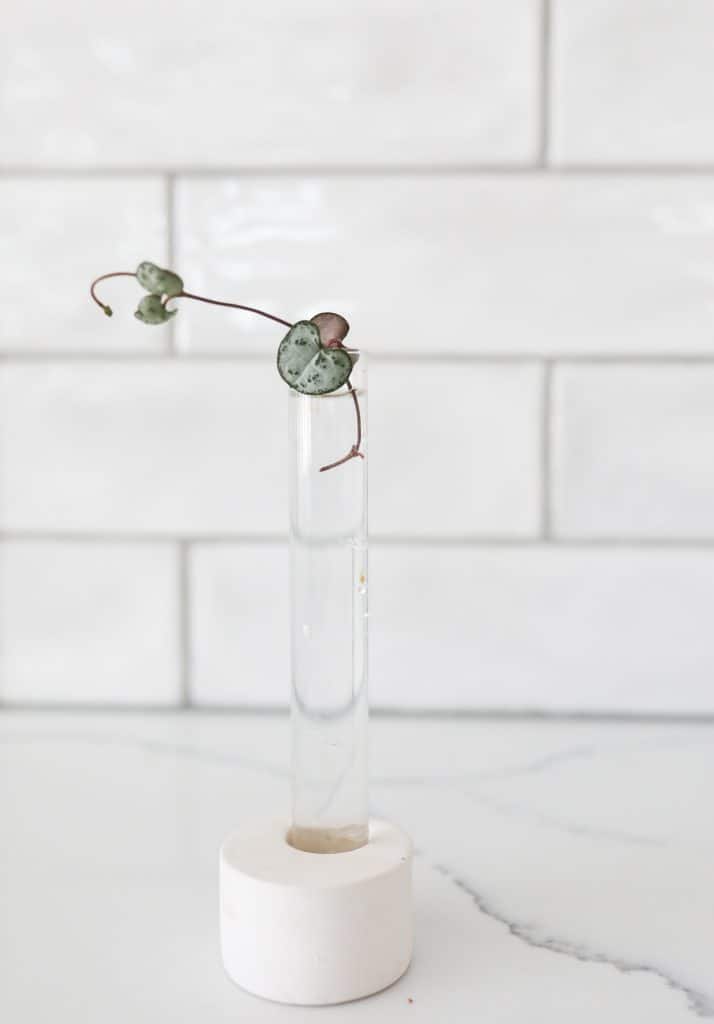
3. Change water weekly
Every week, switch out the water in the jar for fresh water to avoid a build-up of bacteria.
4. Watch for roots
It doesn’t take a long time to start seeing roots! It can take as little as two weeks to see roots growing out from the cut-end of the vine.
5. Plant your cuttings
Transplant your string of hearts cuttings into a well draining soil when the roots have grown to 1 to 2 inches long.
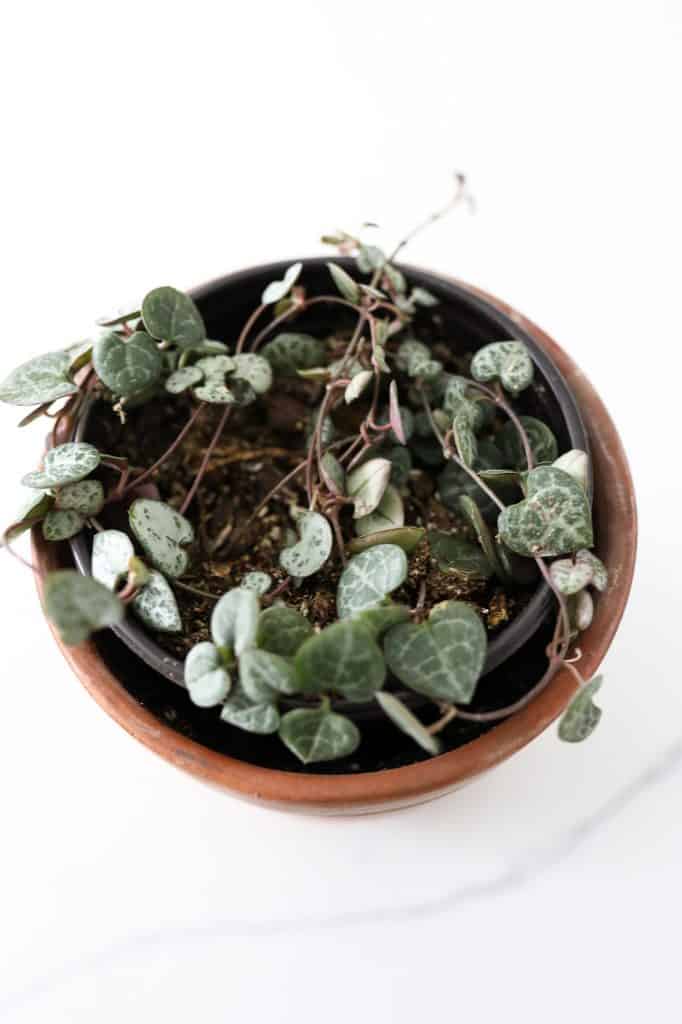
Pros of Water Propagation
With water propagation, you can conveniently watch the roots grow out from the vine cutting.
This way you know exactly how long the roots are when it’s time to transfer into the soil.
Cons of Water Propagation
Placing the stem cuttings in water is an extra step and requires more effort than if you directly propagated your string of hearts into the soil.
2. Soil Propagation
Soil propagation is another easy way to propagate your string of hearts! This requires less steps since you place it directly into the soil. Let’s learn how!
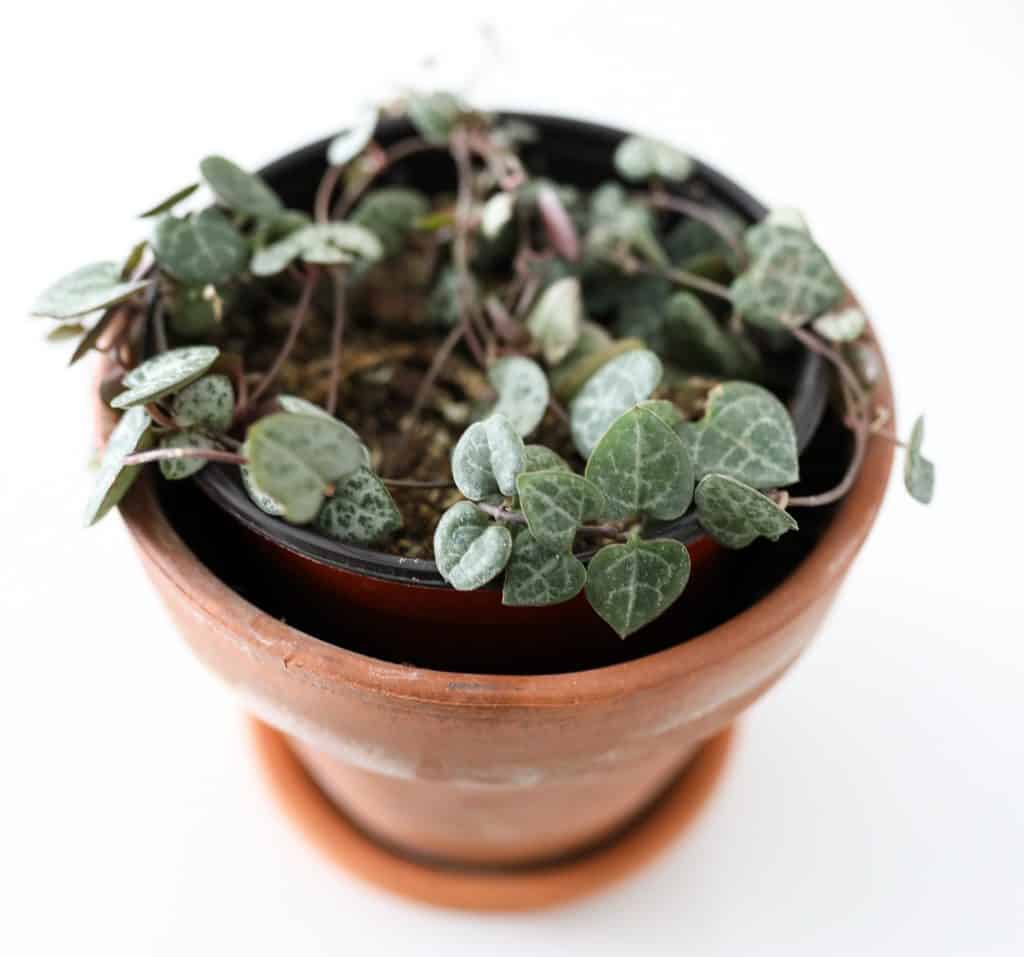
1. Remove a piece of vine
Again, like water propagation, use a pair of sterile, sharp shears or scissors to cut off a piece of the vine. This vine should be at least 3 to 4 inches in length and contain at least two nodes (the stem of the vine that grows leaves).
2. Dip in rooting hormone powder
Technically this is an option step but worth doing to increase the chances of your cutting to root! You’ll want to dip the cut-end of the vine into the rooting hormone powder.
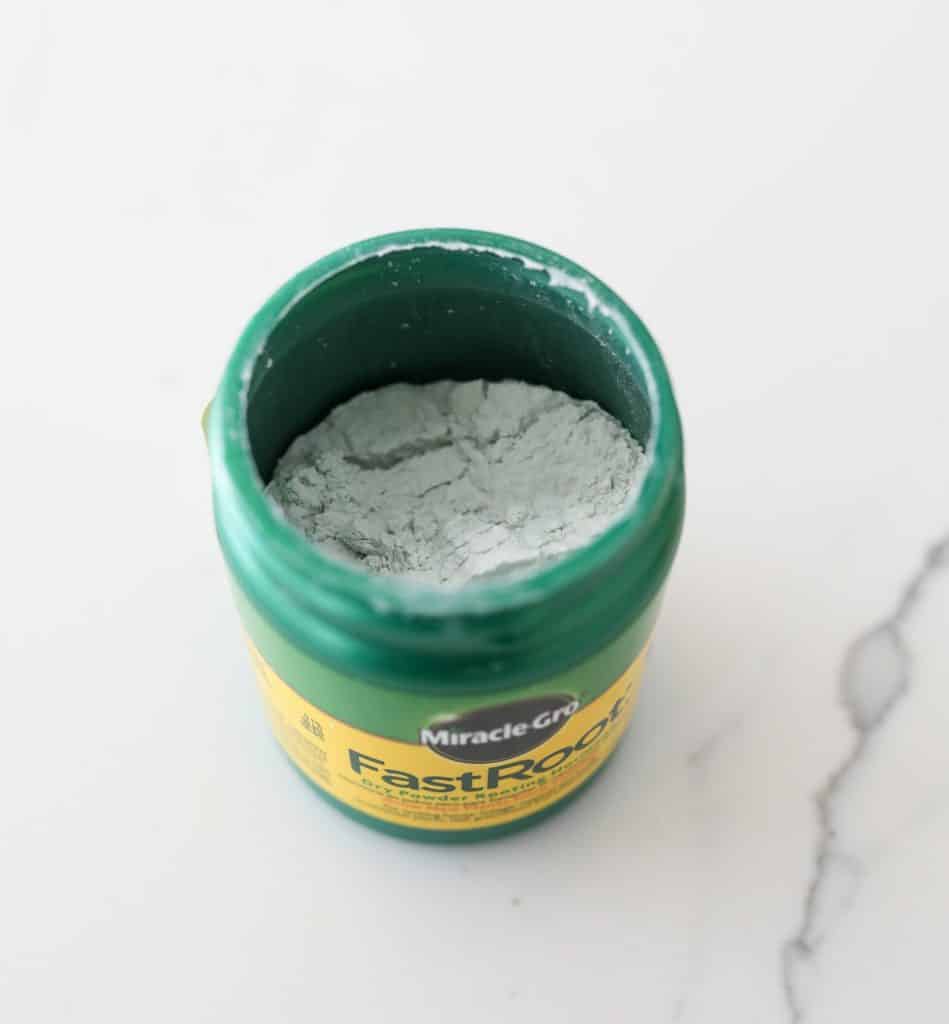
3. Put in soil
Directly place the cut-end into a pot of soil and keep the soil consistently moist.
4. Wait for roots
It can take between two weeks to two months for rooting to occur. You’ll know your plant is rooted when you try to tug on the vine and you feel resistance.
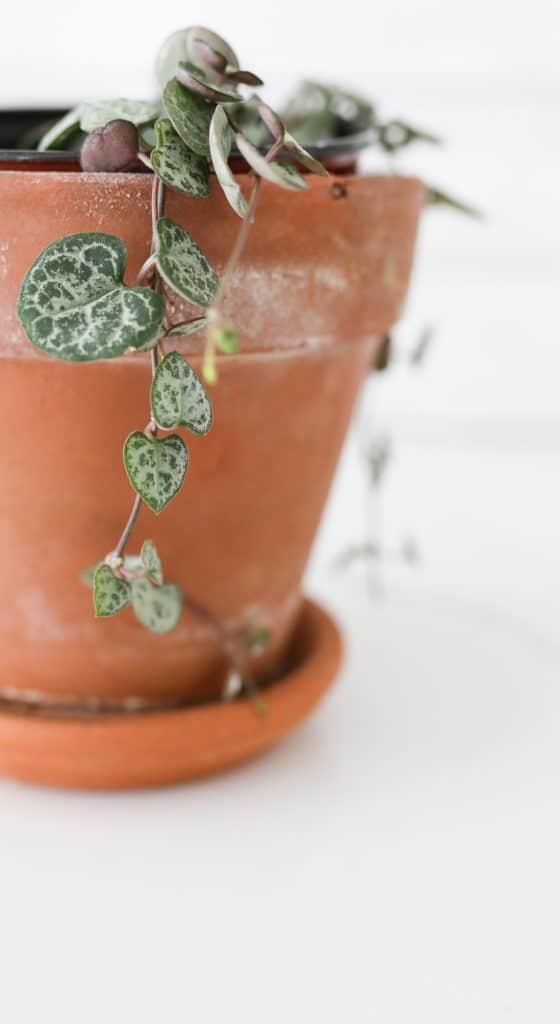
Pros of Soil Propagation
Propagating via soil is a more direct version of water propagation; you skip out the part with the glass of water entirely and immediately transfer the cutting to soil.
Cons of Soil Propagation
Since you can’t see through the soil, it’s impossible to tell if the propagation was successful. You might have to wait upwards of two months to check if the vine successfully rooted into the soil.
3. Tuber Propagation
1. Start with a mature plant
For this method, you’ll need an older string of hearts. These old plants will develop tubers (small, round growths growing on the vine).
2. Remove a large tuber
Select the largest tuber on your string of hearts and cut it off. Leave a little bit of the original vine attached to it.
3. Press tuber into soil
Gently press the tuber into the potting soil. Don’t completely bury the tuber; you should only bury it until it’s halfway into the soil.
4. Keep soil moist and wait for roots
Keep the potting soil consistently moistened; the tuber should begin to root and grow new vines after a few weeks.
*The tuber can also be propagated via water, similar to how we propagated vine cuttings in water the previous section, “Water Propagation.”
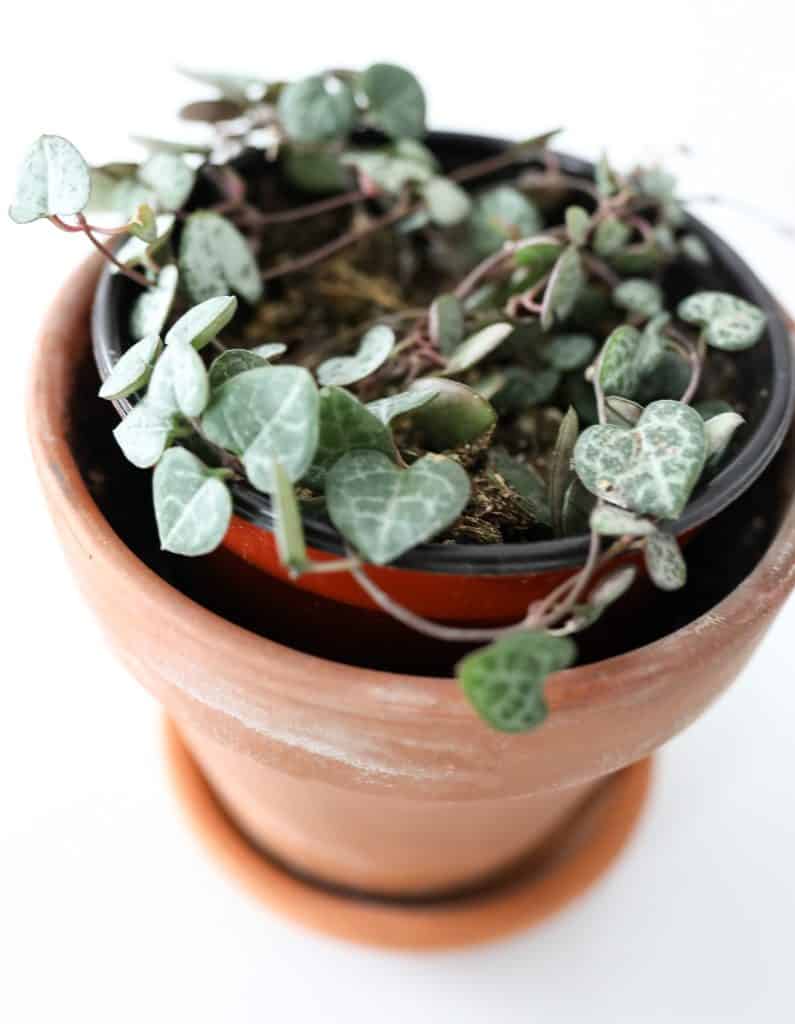
Pros of Tuber Propagation
Tuber propagation is a great way to repurpose older string of hearts plants in the late stages of their lives.
Cons of Tuber Propagation
As stated before, tubers only grow on string of hearts plants when the plant is much older. This method isn’t viable for those with a younger string of hearts.
4. Butterly Method
This one is a bit more advanced than the other two but is another great option!
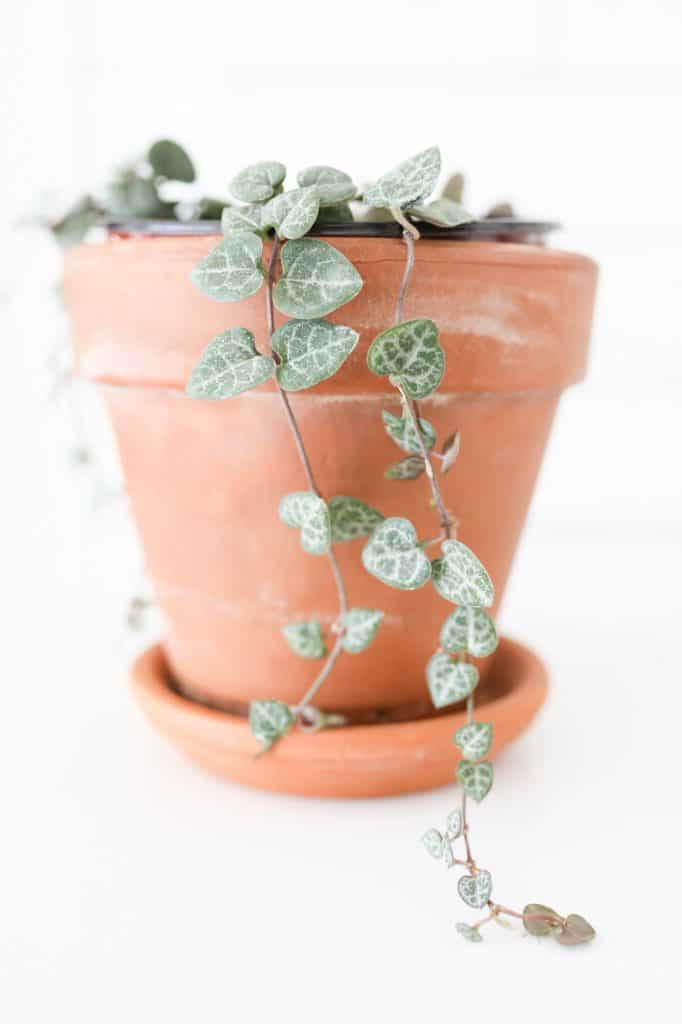
Steps
1. Remove vine with 2 leaves
Locate a part of the vine where a pair of leaves meet the vine. Cut off this section on both sides, leaving about 1/4 of an inch of vine on each side. You should have a small segment of vine with the two leaves attached.
2. Prep sphagnum peat moss
Soak a bowl of sphagnum peat moss in warm water and leave it for 5 minutes. Remove the soaked moss and squeeze the excess moisture out. Lay the moss evenly in a container.
3. Put cuttings on top of sphagnum moss
Place the leaf cuttings on top of the sphagnum moss. The nodes should be touching the moss directly.
4. Cover and put in indirect bright light
Cover the container with a clear lid and place the cuttings in a location with indirect but bright light.
5. Wait for growth
Check back within a couple of weeks and you should notice new growth forming.
6. Pot your cuttings
Transfer the cuttings to a potting mix and care accordingly.
Pros of the Butterfly Method
You’ll maximize the plant material, which in turn leads to a fuller plant.
Cons of the Butterfly Method
This method requires more steps than the previous three methods and could be tedious for gardeners in a hurry.
Care After Propagation
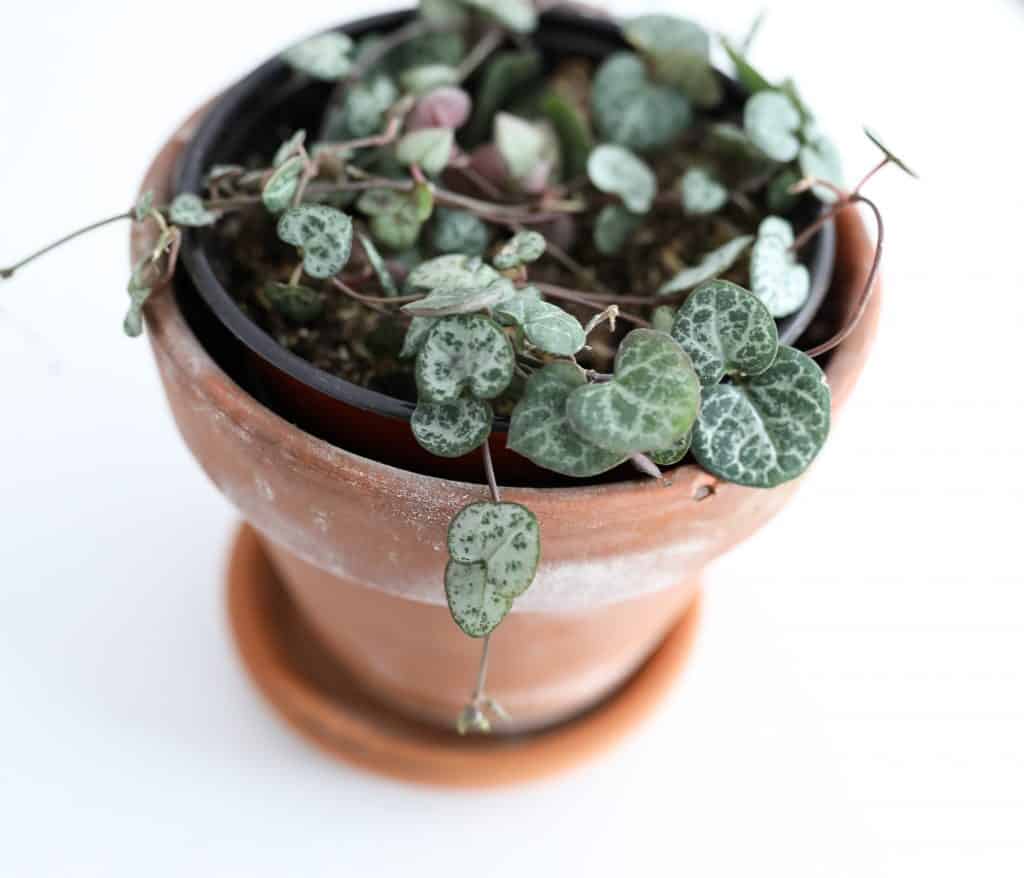
I have a full string of heart care guide here, but here’s the cliff notes version!
String of hearts are fairly easy to care for. First up, the need enough light to survive. Ideally they want bright, indirect light – about 4-6 hours a day.
They need to be watered when the soil has dried out completely. Thoroughly soak the plant when the soil is dry to the touch. It doesn’t like to sit in wet soil so use a succulent or cactus mix soil to ensure proper drainage.

For brief periods of time, the string of hearts can survive cold temperatures as low as 20° F, but that really is not ideal, as it causes severe stress on your plant. An optimal temperature range for the string of hearts is around 65° to 80° F.
Finally, choose a plant pot with a drainage hole. The string of hearts is a succulent plant and therefore does not enjoy sitting in overly damp soil.
FAQ
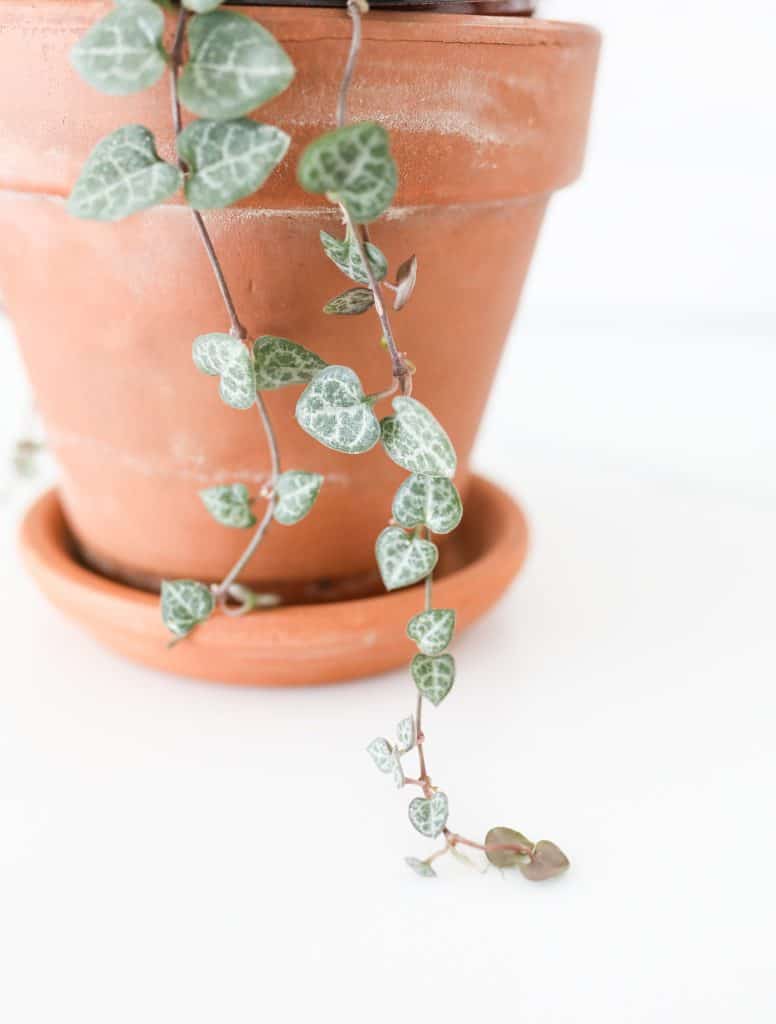
It depends what method of propagation you’re going for. With water and soil propagation, your should cut a piece of vine that is a few inches long. This cut should be made below a few leaf nodes.
When using the butterfly propagation method, you should a small piece of vine that contains a pair of leaves.
With tuber propagation, you need to cut the tuber off from the vine, but leave just a little piece of the vine attached to the tuber.
Propagating a string of hearts plant does not take long at all. When you take all four methods (water, soil, tuber, and butterfly) into consideration, it takes somewhere between two weeks to two months for a propagation to be successfully completed.
If you have an older string of hearts plant, you might notice a white root ball beginning to form on the vines. Don’t worry, these are called aerial tubers- and they are a perfectly normal growth on your string of heart.
They are simply just a sign that your string of heart plant is at an advanced age. You can cut these tubers off and propagate them to create more string of heart plants!
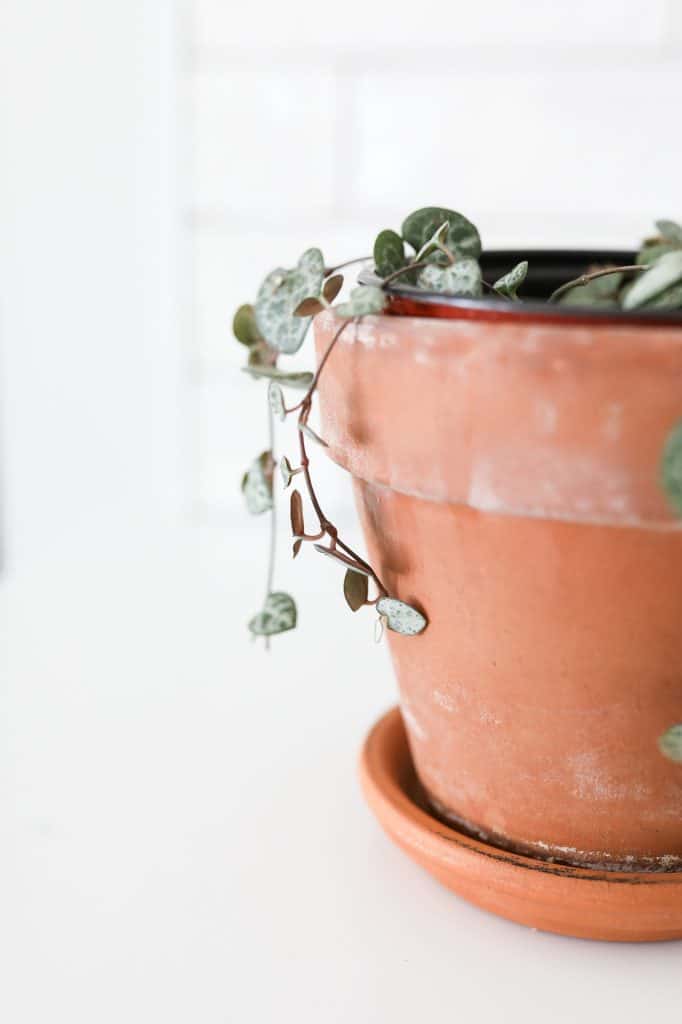
Propagating a string of hearts plant has never been easier. I hope these steps will successfully guide you to multiplying your string of hearts. You can keep your new plant for yourself, or gift them to friends and family!
If you love this string style of plants, check out a few others! A String of Fishhooks plant is one of the easiest succulents I’ve ever grown and I also love the String of Dolphins!

